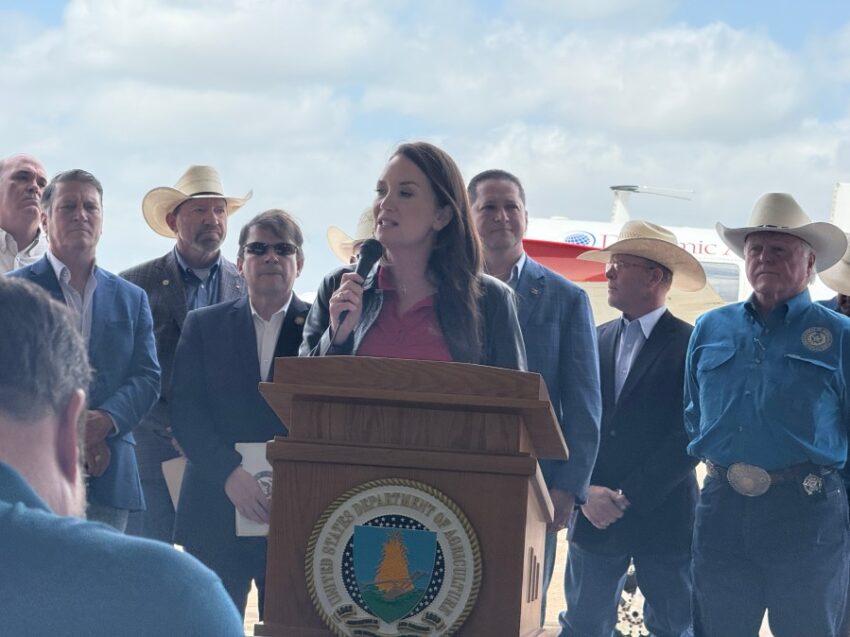EDINBURG, Texas (Border Report) — Secretary of Agriculture Brooke Rollins on Wednesday announce what she called a “bold” new a plan to stop the New World screwworm from crossing the border into the U.S. from Mexico.
Flanked by a bipartisan group of lawmakers, Rollins said the deadly parasite could devastate ranchers who raise cattle, sheep, goats and horses, should it make its way across the southern border.
Rollins spoke from Moore Air Base in Hidalgo County, Texas, from where planes will fly millions of sterilized male screwworms in hopes of eradicating the deadly insect population currently found in southern Mexico.
The U.S. is spending $8.5 million to build a dispersal site at this former Air Force facility. It should be ready in six months and then they hope to drastically increase the number of sterilized pests dropped over the skies of Mexico from the current 110 million per week.
Rollins said $20 million in U.S. funds also will be spent to help upgrade an existing sterilization production facility currently operating in Mexico.
The screwworms are flies that lay their larvae in the wounds of cattle and wildlife. It can cause infections that can kill livestock and hurt people and pets.
The flies were eradicated in the United States in the 1960s but have had a recent uptick and now are in southern Mexico and heading north, officials say.
The plan also calls for a facility to be built at Moore Air Base to create more sterilized flies. But that will take money and congressional approval.
U.S. Sen. Jon Cornyn, R-Texas, and U.S. Rep. Tony Gonzales, R-Texas, have proposed legislation that would appropriate about $300 million to go toward killing the screwworms.
“We’re going to use that plane behind us to bomb those screwworms into eradication. That’s the plan,” Gonzales said.
The lawmakers who joined Rollins say both the U.S. and Mexico are dedicated to stopping the spread.
“We want to be ready should this insect infect Texas,” Texas Agriculture Commissioner Sid Miller said.
Rollins says U.S. officials will also work with Mexican officials and veterinarians to monitor the spread. They’ll engage new technologies and treatments and increase research on the pest to try to find new ways to stop it.
Miller said Texas is investing $250,000 worth of fly traps along the Rio Grande so they can evaluate whether screwworms have crossed onto U.S soil.
He said they’ll screen cruise ships to ensure no “hitchhiker flies” come to the U.S.
Rancher Richard Guerra, 87, was in his 30s when he helped treat cattle that were infected with screwworms on his grandfather’s border ranch in Starr County.

“That was no picnic. We’d have to go everyday and look for cattle that were infected,” Guerra told Border Report. “Everyday, myself and the cowboys, we’d have to go out in the pastures everyday and rope the cattle and try to treat them.”
Susan Kibbe of Jim Wells County, about 75 miles north of the Mexico border, says that a a girl, she was knocked out by an infected horse she was trying to treat.
“We were pushing him in the shoot and he came barreling back before I could push the bar to shut the shoot gate and the gate hit me in the head and knocked me out. The whites of my eye were bloodshot. So, yes scraping them out of the naval of baby calves with a stick, putting gluing medicine inside and then capping that with tar to prevent further infection. It’s hands on,” Kibbe said.
She told Border Report that she worries there aren’t enough cowboys in the industry today, or those with institutional knowledge of this dangerous pest to keep it at bay.
“It’s a devastating pest. Obviously there is a huge sense of urgency,” said Steven Diebel, of Texas and Southwestern Cattle Raiser Association.
But Diebel says he is hopeful that long-term and short-term solutions and binational cooperation will stop this deadly pest from crossing the U.S. border and hurting Texas cattle.
Currently the ports of entry are closed to live cattle from Mexico to stop the spread but that’s hurting the U.S. economy and beef supply.
One industry specialist on Wednesday said the current inventory is down 70%, that’s 500,000 fewer cattle in the U.S. market because of the ban.
Rollins says if this dispersal plan works, as well as other measures, then she thinks some ports of entry could open to cattle from Mexico in upcoming weeks.
The uptick in New World screwworm is being blamed on the COVID-19 pandemic. That’s because since the 1960s eradication effort, the United States has operated a sterilization facility in Panama that has helped to greatly reduce the screwworms population. But during the pandemic inspectors could not do their jobs as usual and the screwworms started to multiply again.
They’re currently in Costa Rica and right now pretty much contained to the Isthmus of Tehuantepec, north of Chiapas in southern Mexico, about 900 miles south of the Rio Grande Valley.
Sandra Sanchez can be reached at SSanchez@BorderReport.com.
 Read: Read More
Read: Read More




